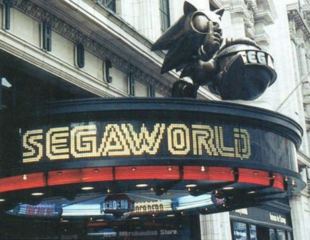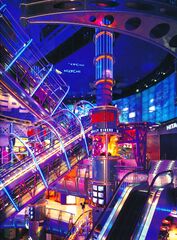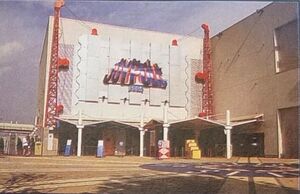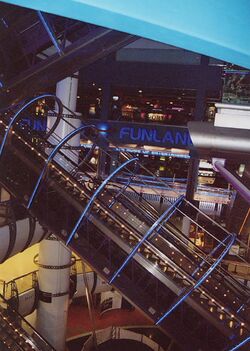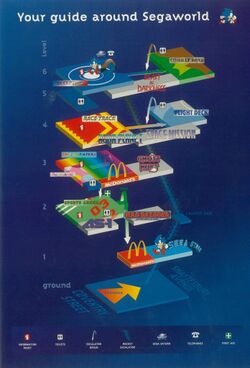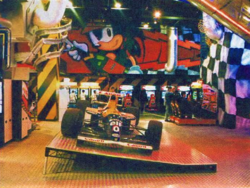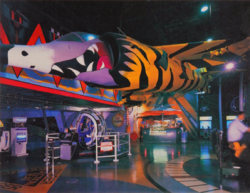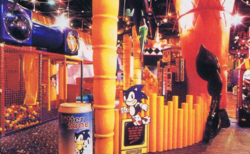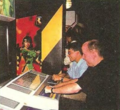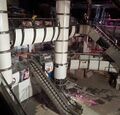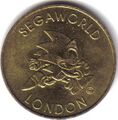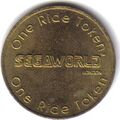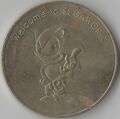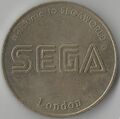Difference between revisions of "SegaWorld London"
From Sega Retro
m (→Gallery) |
(added more info, references, promotional material, etc) |
||
| Line 10: | Line 10: | ||
| closed=1999 | | closed=1999 | ||
}} | }} | ||
| − | '''SegaWorld London''' was a [[Sega World]] indoor theme park which opened on September 7, 1996. It was housed within the London Trocadero complex within the city of London, UK. Upon launch, the Trocadero site became the flagship Sega | + | '''SegaWorld London''' was a [[Sega World]] indoor amusement theme park which opened on September 7, 1996. It was housed within the London Trocadero complex within the city of London, UK. Upon launch, the Trocadero site became the flagship Sega venue in Europe, building on earlier success seen at [[Sega World Bournemouth]]. Upon opening, the centre was said to be the largest indoor theme park in the world, occupying an area of 10200m² on seven floors{{intref|Press release: 1996-09-12: INTERNATIONAL MANAGER : Sega Tests the Theme-Park Route}} and making it the biggest of Sega's venues to have been fully developed (a position which it likely still holds), but has since closed permanently. |
| − | == | + | ==History== |
| − | + | ===Development=== | |
| + | A key building of Central London's tourist district, the Piccadilly Trocadero was given its name in 1896 when redeveloped as a large restaurant by J. Lyons Co., before closing in 1965. It re-opened under the name as an entertainment and shopping complex in 1984, with the backing of infamous British entrepreneur George Walker{{ref|https://www.independent.co.uk/news/business/old-pro-beats-the-count-once-more-1444917.html}}. By the 1990s, the lower floors were home to numerous VR experiences, a Funland arcade, a Guinness World Records tourist attraction, and Alien War, a themed walkthrough attraction based on the Alien films, however it was still struggling to find tenants to fill the large space above them, used at that time for more disposable purposes. In 1994{{ref|https://www.standard.co.uk/hp/front/trocadero-for-sale-at-aps210-million-7170560.html}} it was purchased by Burford Group PLC, led by Nick Leslau and Nigel Wray, who endeavoured to revamp the site and cater to modern consumers further with a large scale permanent tenant. | ||
| + | [[File:JoypolisYokohama_Outside.jpg|thumb|]] | ||
| + | At the same time, [[Sega]] were making moves in opening branded arcade centres across Europe. In the case of the United Kingdom, this began with [[Metropolis (venue)|Metropolis]] in November 1992 and continued with the likes of [[Sega World Bournemouth]] and a handful of smaller venues using the "Sega World" name. Sega itself was one of the biggest brands in the UK at the time, riding on the successes of the [[Sega Master System]] and [[Sega Mega Drive]] (most significantly [[Sonic the Hedgehog]]), and their amusements division, separate from the management dealing with console gaming, benefitted from this association. | ||
| + | |||
| + | Sega were already enjoying initial success in Japan following a similar concept with larger ambition, having operated amusement venues known as game centres in the region since the 60s and expanding on them with the [[Joypolis]] scheme, which began in July 1994 with the opening of the [[Yokohama Joypolis|Yokohama]] location. Effectively indoor theme parks, Joypolis venues typically featured medium scale attractions developed by Sega, alongside the capacity for many coin operated arcade machines and events. | ||
| + | |||
| + | At first, the Trocadero building was intended to be the site for a smaller location, scheduled to open shortly after Sega World Bournemouth{{magref|megapower|2|12}}. However, with further focus was put on expanding operations in other regions of the country, a re-evaluation of the space available, and later encouragement from Burford Group to fill it, the launch was delayed, and plans were altered to make SegaWorld London the European equivalent of Joypolis. Sega's arcade machines could already be found in other parts of the venue - Funland notably featured R360{{magref|hiscore|1|26}} and Virtua Formula{{magref|cvg|149|86}} units. | ||
| + | |||
| + | Construction began in early 1996 on SegaWorld. Projected to cost £45 million, it was to use 110,000 square feet of the Trocadero site, with it aiming to be the largest indoor theme park on the continent. The intended futuristic aesthetic of the venue initiated a refurbishment of the main Trocadero atrium itself. Contracts were made with Tibbatts Associates{{ref|https://www.designweek.co.uk/issues/27-april-1995/tibbatts-leads-segaworld-project/}} and RTKL{{ref|https://www.designweek.co.uk/issues/8-august-1996/rtkl-puts-the-future-into-the-trocadero/}} for the design of the park, Mustoe Merriman and Motive{{ref|https://www.campaignlive.co.uk/article/news-mustoe-merriman-motive-win-pounds-1m-segaworld-work/16248}} for marketing, and Crown Society{{ref|https://segaretro.org/File:SegaWorldLondon_CorporateEntertainment_Back.jpg}} for the planning of corporate hospitality packages, among other firms. During the development process, a separate company, Trocadero PLC, was spun off from Burford Group to handle the running of the centre as a whole{{ref|https://www.referenceforbusiness.com/history2/96/Urbium-PLC.html}}. | ||
| + | |||
| + | Shortly before the opening, a sponsorship deal was made by Trocadero PLC with Pepsi, who would later fund the Pepsi IMAX Theatre and Pepsi Max Drop that could be found in the building. Despite the added exposure created by it, these deals were for the Trocadero itself and did not benefit Sega directly<ref name="marketingweek">[https://www.marketingweek.com/1998/01/22/sega-makes-a-play-to-win-back-top-uk-slot/ Marketing Week: Sega makes a play to win back top UK slot]</ref>, and the attractions were located outside of their space in the main atrium area alongside other unrelated businesses including a HMV megastore and Planet Hollywood. | ||
| + | |||
| + | ===Opening=== | ||
| + | SegaWorld London was opened over a two week period from August-September 1996 with three separate events - a privately held pre-launch preview on 26 August{{ref|https://segaretro.org/images/0/0f/SegaWorldLondonTicket_Back.jpg}}, the official public launch day on 7 September, and a special evening event held for selected [[ECTS Autumn 1996]] press attendees on the following day{{magref|megafun|1996-11|76|}}. The public launch in particular was heavily promoted and hyped up in the media as part of a £1.5 million advertising campaign{{ref|https://www.ipo.gov.uk/t-challenge-decision-results/o15203.pdf}}, and was attended by numerous celebrities. | ||
| + | |||
| + | The launch of the venue did not run smoothly. On the day of the public opening, longer than anticipated queues were said to be common for most attractions, and a lack of enthusiasm for their much-hyped technological feats prevailed. Particularly damning was Nick Leslau's immediate assessment of the site - having offered Sega the chance to build their park and overseeing its development with enthusiasm, he was disheartened by what he saw on opening day. Leslau took much criticism directed at him for his investment in the venture, and would later remark "Sega could not deliver what they said they'd deliver... People were queuing for ages... It was a question of over-anticipation and under-delivery."{{ref|https://www.theguardian.com/business/2011/jul/28/nick-leslau-brings-his-millions-to-londons-ancient-harbour}}. | ||
| − | + | The policies of the park would also prove to be controversial. On top of the £12 entry fee, every individual arcade machine (costing up to £3) was still coin-operated, and no food or drink was permitted to be taken in to the park, with it available for purchase at snack bars and McDonalds outlets located within the park. These moves were seen as excessive in some reviews, with [[Computer & Video Games]] going as far to say "Whoever said that Robotnik is supposed to be the fascist dictator?", in reference to the promotional leaflet's description of the rules supposedly made by Sonic himself{{fileref|CVG UK Freeplay 07.pdf|page=1}}. Due to the generally negative press coverage generated, the opening of the venue came to be regarded as a PR disaster, and did not bode well for the park's fortunes. | |
| − | === | + | ===Demise=== |
| − | + | Despite continued investment, with the additions of new attractions and consistent updates to its roster of arcade games, the centre regularly struggled to meet its expected targets financially. Discouraged by its poor returns, Nick Leslau quit his managerial role, and new management for Trocadero PLC came in the form of ex-First Leisure executives John Conlan and Nick Tamblyn{{ref|https://www.referenceforbusiness.com/history2/96/Urbium-PLC.html}}. Under them, the company moved into acquiring more intellectual property to be implemented into the Trocadero alongside other Central London locations, and Sega were mainly treated with disdain internally - Conlon would later claim that he had "been trying to get rid of SegaWorld" since the day he joined{{ref|https://www.thisismoney.co.uk/money/news/article-1577337/Chorions-Segaworld-game-over.html}}. | |
| − | + | Sega had hoped to attract 1.75 million visitors to the facility in its first full year of operation, but ultimately fell short of this{{ref|https://www.ipo.gov.uk/t-challenge-decision-results/o15203.pdf}}. Entry fees were subsequently dropped to £2 and then scrapped entirely in 1998 to increase footfall - this move worked, with the annual visitor numbers going up to 4 million that year{{ref|https://www.ipo.gov.uk/t-challenge-decision-results/o15203.pdf}}, however it did little to help financially, with many visitors choosing not to spend any money on the attractions within the park, which were now paid for alongside the coin-operated arcade machines. | |
| − | |||
| − | = | + | Sega's ten-year deal with Trocadero PLC included a three-year early termination clause if a £3 million profit had not been achieved <ref name="marketingweek" />, and this was exercised in September 1999 against an overall backdrop of losses in the amusement sector at the company, which shortly afterwards also influenced the closures of several of Japan's Joypolis venues and [[Sega World Sydney]] in Australia. The floors were sublet to Family Leisure (established{{intref|Press release: 2008-09-08: Industry icon Marty Bromley passes away}}{{ref|https://web.archive.org/web/20020410152332/http://vegauniverse.com/corporb.htm}} by [[Martin Bromley]]), operators of numerous arcades elsewhere in London. One of these was Funland, situated just below SegaWorld in the Trocadero building, and plans began to rename the floors accordingly. The centre was officially stripped of any SegaWorld branding in February 2000. |
| − | |||
| − | === | + | ===Aftermath=== |
| − | + | In the years that followed, the site was stripped down considerably. Around the same time Sega pulled out, Pepsi cancelled their sponsorship deal, closing the IMAX theatre and renaming the Pepsi Max Drop to "London's Scream Ride"{{ref|https://i229.photobucket.com/albums/ee94/thefoudnation/london15.jpg}}; the physical Pepsi Max Drop ride itself was later sold and moved to the unrelated Funland Hayling Island amusement park in 2003. The Trocadero itself also became directly managed by Burford Group (now Burford Holdings) again - Trocadero PLC had since been renamed Chorion, who now owned properties such as the popular Tiger Tiger bar elsewhere in London{{ref|https://www.referenceforbusiness.com/history2/96/Urbium-PLC.html}}. | |
| + | [[File:Trocadero2004.jpg|thumb|250px]] | ||
| + | Assuming full control of the former SegaWorld space, Family Leisure joined their two pre-existing Funland floors up to the upper six, and ran them together as a large Family Entertainment Centre. Most of the Sega-era features were taken out and replaced with new attractions intended to broaden the appeal of the centre, including a bowling alley, sports bar, and conventional fairground rides{{ref|http://www.proun.co.uk/leisure#/funland/}}. A new façade was also constructed to the right of the Trocadero's central atrium, incorporating balconies and neon signs, though décor from the old themes was kept intact in some areas. | ||
| − | + | Funland's operators were not accustomed to running an arcade of its size, having only dealt with much smaller venues in their past. Floors were often understaffed, leading to ongoing crime and antisocial behaviour issues from both visitors and some employees{{ref|http://news.bbc.co.uk/1/hi/uk/1096914.stm}}. This and the increased dominance of consoles over arcade gaming made management come to the decision of renewing Funland's lease to only cover two floors in September 2002{{ref|https://www.casemine.com/judgement/uk/5a8ff71960d03e7f57ea785c}}, effectively permanently closing the upper four in the process. As a result, the second rocket escalator that went to them was stopped and blocked off (although it took until May 2011 for it to be physically removed). | |
| − | + | At no point was the complex significantly revamped, meaning traces of the SegaWorld layout and closed rides still existed for much of the rest of the decade. Numerous wall murals remained in the closed off floors, most significantly artwork of a large aircraft control panel on the back wall of what used to be the Flight Deck{{ref|https://3.bp.blogspot.com/-IQO53Njw_qI/WdjMwqRsJWI/AAAAAAAAAaI/TaH5RcMm7c4wOFWYltpE-e7rAV380BPRwCLcBGAs/s1600/trocclosed6.jpg}}. The first rocket escalator was kept operational to take visitors up to what was left of Funland, where a walk way had been made to join the second floor up to the midway podium between the two escalators. | |
| − | |||
| − | + | Despite finding success in rhythm action games during the 2000s, Funland started to decay, and ceased operations altogether in July 2011{{ref|https://www.facebook.com/FunlandTrocadero/posts/10150250215896250}} after internal money management issues at Family Leisure and an acrimonious lease dispute with the Trocadero's new property owners, Criterion. Its founder, Asif Aziz, had planned to convert the building into a hotel since its acquisition in 2005{{ref|https://www.standard.co.uk/news/london/trocadero-to-be-transformed-into-tokyostyle-pod-hotel-8052753.html}}, and could not come to an agreement that involved Funland's space staying occupied. After this, the centre's machines were bought by other arcades, shifted to the front of Funland's shuttered entrance, and maintained by two makeshift venues in the basement, until the final closure of the Trocadero as an entertainment centre in February 2014{{ref|https://ukarcaderacers.wordpress.com/2014/02/14/london-trocadero-will-close-for-good-on-february-25-2014/}}. | |
| − | |||
| − | == | + | ==Layout== |
| − | + | [[File:SegaWorldLondonMap.jpg|thumb|250px]] | |
| − | + | Taking up over 100,000 of the Trocadero's 600,000 square feet, SegaWorld London was a six-floor indoor amusement theme park. Whilst billed as such, much of its floor space was in fact taken up by its large amount of arcade machines, including full-size 8-player iterations of games such as [[Daytona USA]], and import titles rarely seen in the UK. Alongside numerous other Sega venues, it was specifically used for the location testing of both upcoming and never released titles. | |
| − | + | After entering the Trocadero building through its shopping arcade area, visitors would be taken up the "rocket escalator", (16.43m in length (with 80m of handrail), 31.5 tons in weight and 193 steps{{magref|cvg|175|57}} (although it was technically two escalators, not one)), running through the main atrium containing unrelated attractions, to the sixth "level" (floor). This acted as the park's reception, with each subsequent floor based around differing themes and concepts. For the most part, the arcade machines on these floors were kept in line with the designated theming, and various other attractions and amenities could be found between them, including a McDonalds restaurant and other snack bars. | |
| − | + | The floors themselves were connected through a further series of escalators and travelators, usually situated on the left and right sides at the top of the Trocadero's main atrium area. Also located in the atrium was the official Sega Shop, which sold exclusive merchandise and games. Alongside a second McDonalds outlet, the retail unit it was housed in was positioned directly opposite to the bottom of the exit escalator, although it was later moved up to the Sports Arena floor. | |
| − | + | ===Level 6: Reception=== | |
| + | On this floor, visitors could obtain tokens and attraction tickets, have photos taken with statues of Sonic the Hedgehog (the de-facto mascot of the park), and try a selection of free to play [[Sega Saturn]] consoles. Also housed here was an information centre for the park, video screens displaying promotional films, and the first attraction, [[Beast In Darkness]]. | ||
| − | === | + | ===Level 5: Combat Zone=== |
| − | + | The Combat Zone floor was more akin to a dimly-lit conventional arcade, featuring black and yellow striped décor and no significant attractions. Its space was instead devoted to a selection of over 50 action games, with genres ranging from fighting to shooters. At launch, games included [[Virtua Cop 2]] and [[Fighting Vipers]], as well as non-Sega titles like Time Crisis and Area 51. | |
| − | + | ===Level 4: The Race Track=== | |
| + | [[File:RaceTrack.png|thumb|250px]] | ||
| + | Boasting extensive theming, with replicas of race cars in the walls and giant traffic lights, The Race Track featured over 70 racing games, most notably back to back 8 player deluxe setups of [[Daytona USA]] and [[Manx TT Superbike]]. The ride on this floor, officially known as [[Aqua Nova]] at other Sega amusement theme parks, was renamed to Aqua Planet. | ||
| − | + | One of Damon Hill's FW15C racing cars from the 1993 Formula One season was also situated on the floor for photo opportunities. During that season, Hill drove with Alain Prost for Williams, who were famously sponsored by Sega at the time. Incidentally, Prost partly owned the La Tête dans les Nuages entertainment centre chain in France, whose Paris location contained a [[Centre Sega]] arcade. | |
| − | + | ===Level 3: Flight Deck=== | |
| + | [[File:FlightDeck1.png|thumb|250px]] | ||
| + | Themed around aviation, this floor featured 20 "flying" games. At one point in time, these notably included [[Dennou Senki Net Merc|Sega Net Merc]] and [[R-360]] machines, the former of which was originally located on the Combat Zone floor at launch. | ||
| − | + | Often promoted as the venue's main attraction, much of the Flight Deck's space was taken up by [[VR-1|VR-1: Space Mission]], the park's most technologically advanced attraction (though it had already made its debut in numerous of Sega's Japan venues a couple of years beforehand). | |
| − | |||
| − | + | Hanging from its ceiling was the first commercially available ex-RAF Harrier Jump Jet. This was transported to the venue in the months prior to the park's opening by being towed through London on a boat for a PR event, subsequently reported on by [[Computer & Video Games]] magazine{{magref|cvg|177|8}}. | |
| − | + | ===Level 2: The Carnival=== | |
| + | [[File:Carnival.png|thumb|250px]] | ||
| + | The Carnival contained over 80 arcade games, which were typically [[UFO Catcher|UFO Catchers]] and ticket redemption. As such, a prize desk could be found here, offering merchandise and Sega consoles. Also located on this floor was the "Segakids" section, featuring a McDonalds outlet and a play area for young children. | ||
| − | + | Initially only one attraction was located on the floor, [[Ghost Hunters]] (localised and adapted under the name of Ghost Hunt); this number later increased to three with the additions of [[House of Grandish]] in 1997 and [[Power Sled]] in 1998. | |
| − | + | ===Level 1: Sports Arena=== | |
| + | The final floor, Sports Arena, housed over 90 sports games (including [[Virtua Striker]] and [[Sega Bass Fishing]]), as well as [[Mad Bazooka]] (removed after 1998) and [[AS-1]] attractions. | ||
| − | + | After the removal of Mad Bazooka, the Sega Shop, originally located to the left of the exit escalator, was moved upstairs to the space it once occupied. | |
| − | + | ==Major attractions== | |
| + | * [[Beast In Darkness]]'' | ||
| + | * ''[[Aqua Nova]]'' | ||
| + | * ''[[VR-1]]'' | ||
| + | * ''[[Ghost Hunters]]'' | ||
| + | * ''[[House of Grandish]]'' | ||
| + | * ''[[Power Sled]]'' | ||
| + | * ''[[AS-1]]'' | ||
| + | * ''[[Mad Bazooka]]'' | ||
==Gallery== | ==Gallery== | ||
<gallery> | <gallery> | ||
Cucciolo IT Video 1998 (SegaWorldLondon).mp4|A scene from the 1998 Italian comedy film ''[[wikipedia:Cucciolo (film)|Cucciolo]]''{{ref|https://archive.vn/E3v8B/730ac7066d13cbe47e666e4c568dfd894dc6a5f7.jpg|https://i.ibb.co/2dpHbqg/Cucciolo-IT-Poster-1998.jpg}}, shot on location at Sega World London | Cucciolo IT Video 1998 (SegaWorldLondon).mp4|A scene from the 1998 Italian comedy film ''[[wikipedia:Cucciolo (film)|Cucciolo]]''{{ref|https://archive.vn/E3v8B/730ac7066d13cbe47e666e4c568dfd894dc6a5f7.jpg|https://i.ibb.co/2dpHbqg/Cucciolo-IT-Poster-1998.jpg}}, shot on location at Sega World London | ||
| − | SegaWorldLondonOutside.jpg| The outside of the Trocadero | + | SegaWorldLondonOutside.jpg| The outside of the Trocadero with Sega signs + Sonic statue, circa 1997. |
SegaWorldLondonEntrance.jpg| The entrance to SegaWorld at the bottom of the Rocket Escalator. | SegaWorldLondonEntrance.jpg| The entrance to SegaWorld at the bottom of the Rocket Escalator. | ||
SegaWorldLondonAtrium.jpg| Main atrium. | SegaWorldLondonAtrium.jpg| Main atrium. | ||
| Line 90: | Line 119: | ||
Carnival.png| The "SegaKids" play area, on the Carnival floor. | Carnival.png| The "SegaKids" play area, on the Carnival floor. | ||
Carnival2.png| Different view of the same area. | Carnival2.png| Different view of the same area. | ||
| − | SportsArena1.png| | + | SportsArena1.png| Sports Arena floor |
| − | SportsArena2.png| Megalo cabinets | + | SportsArena2.png| Megalo cabinets |
Trocadero2001.jpg| Funland's changes to the SegaWorld floors and atrium, circa 2001. | Trocadero2001.jpg| Funland's changes to the SegaWorld floors and atrium, circa 2001. | ||
FunlandDodgems.jpg| A bumper car track installed by Funland, on what was the Carnival floor. | FunlandDodgems.jpg| A bumper car track installed by Funland, on what was the Carnival floor. | ||
SegaWorld London blockage.jpg|Between 2002 and 2011, the Rocket Escalator was noticeably blocked by a Coca-Cola vending machine. | SegaWorld London blockage.jpg|Between 2002 and 2011, the Rocket Escalator was noticeably blocked by a Coca-Cola vending machine. | ||
Trocadero2004.jpg| Trocadero in 2004, with a visibly boarded up upper floor. | Trocadero2004.jpg| Trocadero in 2004, with a visibly boarded up upper floor. | ||
| − | FunLand Entrance.jpg| The stripped-down | + | FunLand Entrance.jpg| The stripped-down Funland entrance. |
FunLand 2011.jpg|The remains of the arcade, 2011. | FunLand 2011.jpg|The remains of the arcade, 2011. | ||
| − | FunLand 2014.jpg|The | + | FunLand 2014.jpg|The demolition of the basement. |
SegaWorldLondon Token Heads.jpg|Token (heads) | SegaWorldLondon Token Heads.jpg|Token (heads) | ||
SegaWorldLondon Token Tails.jpg|Token (tails) | SegaWorldLondon Token Tails.jpg|Token (tails) | ||
| Line 108: | Line 137: | ||
<gallery> | <gallery> | ||
SegaWorldLondon Penny.jpg|Squashed penny | SegaWorldLondon Penny.jpg|Squashed penny | ||
| + | SegaWorldLondonTicket_Front.jpg|Front of ticket issued for park entry | ||
| + | SegaWorldLondonTicket_Back.jpg|Back of ticket issued for park entry | ||
</gallery> | </gallery> | ||
| Line 116: | Line 147: | ||
<gallery> | <gallery> | ||
File:SegaWorldLondon Leaflet 1998.pdf|Leaflet, circa 1998 | File:SegaWorldLondon Leaflet 1998.pdf|Leaflet, circa 1998 | ||
| + | File:SegaWorldLondon CorporateEntertainment Front.jpg|Front of booklet promoting corporate hospitality packages | ||
| + | File:SegaWorldLondon CorporateEntertainment Inside.jpg|Inside of booklet promoting corporate hospitality packages | ||
| + | File:SegaWorldLondon CorporateEntertainment Back.jpg|Back of booklet promoting corporate hospitality packages | ||
</gallery> | </gallery> | ||
Revision as of 01:06, 18 February 2021
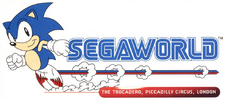
|
| SegaWorld London |
|---|
| Location: The Trocadero, London, United Kingdom |
| Google maps: 51.510490,-0.133022 |
| Opened: 1996-09-07[1] |
| Closed: 1999 |
SegaWorld London was a Sega World indoor amusement theme park which opened on September 7, 1996. It was housed within the London Trocadero complex within the city of London, UK. Upon launch, the Trocadero site became the flagship Sega venue in Europe, building on earlier success seen at Sega World Bournemouth. Upon opening, the centre was said to be the largest indoor theme park in the world, occupying an area of 10200m² on seven floors[2] and making it the biggest of Sega's venues to have been fully developed (a position which it likely still holds), but has since closed permanently.
Contents
History
Development
A key building of Central London's tourist district, the Piccadilly Trocadero was given its name in 1896 when redeveloped as a large restaurant by J. Lyons Co., before closing in 1965. It re-opened under the name as an entertainment and shopping complex in 1984, with the backing of infamous British entrepreneur George Walker[3]. By the 1990s, the lower floors were home to numerous VR experiences, a Funland arcade, a Guinness World Records tourist attraction, and Alien War, a themed walkthrough attraction based on the Alien films, however it was still struggling to find tenants to fill the large space above them, used at that time for more disposable purposes. In 1994[4] it was purchased by Burford Group PLC, led by Nick Leslau and Nigel Wray, who endeavoured to revamp the site and cater to modern consumers further with a large scale permanent tenant.
At the same time, Sega were making moves in opening branded arcade centres across Europe. In the case of the United Kingdom, this began with Metropolis in November 1992 and continued with the likes of Sega World Bournemouth and a handful of smaller venues using the "Sega World" name. Sega itself was one of the biggest brands in the UK at the time, riding on the successes of the Sega Master System and Sega Mega Drive (most significantly Sonic the Hedgehog), and their amusements division, separate from the management dealing with console gaming, benefitted from this association.
Sega were already enjoying initial success in Japan following a similar concept with larger ambition, having operated amusement venues known as game centres in the region since the 60s and expanding on them with the Joypolis scheme, which began in July 1994 with the opening of the Yokohama location. Effectively indoor theme parks, Joypolis venues typically featured medium scale attractions developed by Sega, alongside the capacity for many coin operated arcade machines and events.
At first, the Trocadero building was intended to be the site for a smaller location, scheduled to open shortly after Sega World Bournemouth[5]. However, with further focus was put on expanding operations in other regions of the country, a re-evaluation of the space available, and later encouragement from Burford Group to fill it, the launch was delayed, and plans were altered to make SegaWorld London the European equivalent of Joypolis. Sega's arcade machines could already be found in other parts of the venue - Funland notably featured R360[6] and Virtua Formula[7] units.
Construction began in early 1996 on SegaWorld. Projected to cost £45 million, it was to use 110,000 square feet of the Trocadero site, with it aiming to be the largest indoor theme park on the continent. The intended futuristic aesthetic of the venue initiated a refurbishment of the main Trocadero atrium itself. Contracts were made with Tibbatts Associates[8] and RTKL[9] for the design of the park, Mustoe Merriman and Motive[10] for marketing, and Crown Society[11] for the planning of corporate hospitality packages, among other firms. During the development process, a separate company, Trocadero PLC, was spun off from Burford Group to handle the running of the centre as a whole[12].
Shortly before the opening, a sponsorship deal was made by Trocadero PLC with Pepsi, who would later fund the Pepsi IMAX Theatre and Pepsi Max Drop that could be found in the building. Despite the added exposure created by it, these deals were for the Trocadero itself and did not benefit Sega directly[13], and the attractions were located outside of their space in the main atrium area alongside other unrelated businesses including a HMV megastore and Planet Hollywood.
Opening
SegaWorld London was opened over a two week period from August-September 1996 with three separate events - a privately held pre-launch preview on 26 August[14], the official public launch day on 7 September, and a special evening event held for selected ECTS Autumn 1996 press attendees on the following day[15]. The public launch in particular was heavily promoted and hyped up in the media as part of a £1.5 million advertising campaign[16], and was attended by numerous celebrities.
The launch of the venue did not run smoothly. On the day of the public opening, longer than anticipated queues were said to be common for most attractions, and a lack of enthusiasm for their much-hyped technological feats prevailed. Particularly damning was Nick Leslau's immediate assessment of the site - having offered Sega the chance to build their park and overseeing its development with enthusiasm, he was disheartened by what he saw on opening day. Leslau took much criticism directed at him for his investment in the venture, and would later remark "Sega could not deliver what they said they'd deliver... People were queuing for ages... It was a question of over-anticipation and under-delivery."[17].
The policies of the park would also prove to be controversial. On top of the £12 entry fee, every individual arcade machine (costing up to £3) was still coin-operated, and no food or drink was permitted to be taken in to the park, with it available for purchase at snack bars and McDonalds outlets located within the park. These moves were seen as excessive in some reviews, with Computer & Video Games going as far to say "Whoever said that Robotnik is supposed to be the fascist dictator?", in reference to the promotional leaflet's description of the rules supposedly made by Sonic himself[1]. Due to the generally negative press coverage generated, the opening of the venue came to be regarded as a PR disaster, and did not bode well for the park's fortunes.
Demise
Despite continued investment, with the additions of new attractions and consistent updates to its roster of arcade games, the centre regularly struggled to meet its expected targets financially. Discouraged by its poor returns, Nick Leslau quit his managerial role, and new management for Trocadero PLC came in the form of ex-First Leisure executives John Conlan and Nick Tamblyn[12]. Under them, the company moved into acquiring more intellectual property to be implemented into the Trocadero alongside other Central London locations, and Sega were mainly treated with disdain internally - Conlon would later claim that he had "been trying to get rid of SegaWorld" since the day he joined[18].
Sega had hoped to attract 1.75 million visitors to the facility in its first full year of operation, but ultimately fell short of this[16]. Entry fees were subsequently dropped to £2 and then scrapped entirely in 1998 to increase footfall - this move worked, with the annual visitor numbers going up to 4 million that year[16], however it did little to help financially, with many visitors choosing not to spend any money on the attractions within the park, which were now paid for alongside the coin-operated arcade machines.
Sega's ten-year deal with Trocadero PLC included a three-year early termination clause if a £3 million profit had not been achieved [13], and this was exercised in September 1999 against an overall backdrop of losses in the amusement sector at the company, which shortly afterwards also influenced the closures of several of Japan's Joypolis venues and Sega World Sydney in Australia. The floors were sublet to Family Leisure (established[19][20] by Martin Bromley), operators of numerous arcades elsewhere in London. One of these was Funland, situated just below SegaWorld in the Trocadero building, and plans began to rename the floors accordingly. The centre was officially stripped of any SegaWorld branding in February 2000.
Aftermath
In the years that followed, the site was stripped down considerably. Around the same time Sega pulled out, Pepsi cancelled their sponsorship deal, closing the IMAX theatre and renaming the Pepsi Max Drop to "London's Scream Ride"[21]; the physical Pepsi Max Drop ride itself was later sold and moved to the unrelated Funland Hayling Island amusement park in 2003. The Trocadero itself also became directly managed by Burford Group (now Burford Holdings) again - Trocadero PLC had since been renamed Chorion, who now owned properties such as the popular Tiger Tiger bar elsewhere in London[12].
Assuming full control of the former SegaWorld space, Family Leisure joined their two pre-existing Funland floors up to the upper six, and ran them together as a large Family Entertainment Centre. Most of the Sega-era features were taken out and replaced with new attractions intended to broaden the appeal of the centre, including a bowling alley, sports bar, and conventional fairground rides[22]. A new façade was also constructed to the right of the Trocadero's central atrium, incorporating balconies and neon signs, though décor from the old themes was kept intact in some areas.
Funland's operators were not accustomed to running an arcade of its size, having only dealt with much smaller venues in their past. Floors were often understaffed, leading to ongoing crime and antisocial behaviour issues from both visitors and some employees[23]. This and the increased dominance of consoles over arcade gaming made management come to the decision of renewing Funland's lease to only cover two floors in September 2002[24], effectively permanently closing the upper four in the process. As a result, the second rocket escalator that went to them was stopped and blocked off (although it took until May 2011 for it to be physically removed).
At no point was the complex significantly revamped, meaning traces of the SegaWorld layout and closed rides still existed for much of the rest of the decade. Numerous wall murals remained in the closed off floors, most significantly artwork of a large aircraft control panel on the back wall of what used to be the Flight Deck[25]. The first rocket escalator was kept operational to take visitors up to what was left of Funland, where a walk way had been made to join the second floor up to the midway podium between the two escalators.
Despite finding success in rhythm action games during the 2000s, Funland started to decay, and ceased operations altogether in July 2011[26] after internal money management issues at Family Leisure and an acrimonious lease dispute with the Trocadero's new property owners, Criterion. Its founder, Asif Aziz, had planned to convert the building into a hotel since its acquisition in 2005[27], and could not come to an agreement that involved Funland's space staying occupied. After this, the centre's machines were bought by other arcades, shifted to the front of Funland's shuttered entrance, and maintained by two makeshift venues in the basement, until the final closure of the Trocadero as an entertainment centre in February 2014[28].
Layout
Taking up over 100,000 of the Trocadero's 600,000 square feet, SegaWorld London was a six-floor indoor amusement theme park. Whilst billed as such, much of its floor space was in fact taken up by its large amount of arcade machines, including full-size 8-player iterations of games such as Daytona USA, and import titles rarely seen in the UK. Alongside numerous other Sega venues, it was specifically used for the location testing of both upcoming and never released titles.
After entering the Trocadero building through its shopping arcade area, visitors would be taken up the "rocket escalator", (16.43m in length (with 80m of handrail), 31.5 tons in weight and 193 steps[29] (although it was technically two escalators, not one)), running through the main atrium containing unrelated attractions, to the sixth "level" (floor). This acted as the park's reception, with each subsequent floor based around differing themes and concepts. For the most part, the arcade machines on these floors were kept in line with the designated theming, and various other attractions and amenities could be found between them, including a McDonalds restaurant and other snack bars.
The floors themselves were connected through a further series of escalators and travelators, usually situated on the left and right sides at the top of the Trocadero's main atrium area. Also located in the atrium was the official Sega Shop, which sold exclusive merchandise and games. Alongside a second McDonalds outlet, the retail unit it was housed in was positioned directly opposite to the bottom of the exit escalator, although it was later moved up to the Sports Arena floor.
Level 6: Reception
On this floor, visitors could obtain tokens and attraction tickets, have photos taken with statues of Sonic the Hedgehog (the de-facto mascot of the park), and try a selection of free to play Sega Saturn consoles. Also housed here was an information centre for the park, video screens displaying promotional films, and the first attraction, Beast In Darkness.
Level 5: Combat Zone
The Combat Zone floor was more akin to a dimly-lit conventional arcade, featuring black and yellow striped décor and no significant attractions. Its space was instead devoted to a selection of over 50 action games, with genres ranging from fighting to shooters. At launch, games included Virtua Cop 2 and Fighting Vipers, as well as non-Sega titles like Time Crisis and Area 51.
Level 4: The Race Track
Boasting extensive theming, with replicas of race cars in the walls and giant traffic lights, The Race Track featured over 70 racing games, most notably back to back 8 player deluxe setups of Daytona USA and Manx TT Superbike. The ride on this floor, officially known as Aqua Nova at other Sega amusement theme parks, was renamed to Aqua Planet.
One of Damon Hill's FW15C racing cars from the 1993 Formula One season was also situated on the floor for photo opportunities. During that season, Hill drove with Alain Prost for Williams, who were famously sponsored by Sega at the time. Incidentally, Prost partly owned the La Tête dans les Nuages entertainment centre chain in France, whose Paris location contained a Centre Sega arcade.
Level 3: Flight Deck
Themed around aviation, this floor featured 20 "flying" games. At one point in time, these notably included Sega Net Merc and R-360 machines, the former of which was originally located on the Combat Zone floor at launch.
Often promoted as the venue's main attraction, much of the Flight Deck's space was taken up by VR-1: Space Mission, the park's most technologically advanced attraction (though it had already made its debut in numerous of Sega's Japan venues a couple of years beforehand).
Hanging from its ceiling was the first commercially available ex-RAF Harrier Jump Jet. This was transported to the venue in the months prior to the park's opening by being towed through London on a boat for a PR event, subsequently reported on by Computer & Video Games magazine[30].
Level 2: The Carnival
The Carnival contained over 80 arcade games, which were typically UFO Catchers and ticket redemption. As such, a prize desk could be found here, offering merchandise and Sega consoles. Also located on this floor was the "Segakids" section, featuring a McDonalds outlet and a play area for young children.
Initially only one attraction was located on the floor, Ghost Hunters (localised and adapted under the name of Ghost Hunt); this number later increased to three with the additions of House of Grandish in 1997 and Power Sled in 1998.
Level 1: Sports Arena
The final floor, Sports Arena, housed over 90 sports games (including Virtua Striker and Sega Bass Fishing), as well as Mad Bazooka (removed after 1998) and AS-1 attractions.
After the removal of Mad Bazooka, the Sega Shop, originally located to the left of the exit escalator, was moved upstairs to the space it once occupied.
Major attractions
Gallery
Merchandise
Magazine articles
- Main article: SegaWorld London/Magazine articles.
Promotional material
External links
References
- ↑ 1.0 1.1 File:CVG UK Freeplay 07.pdf, page 1
- ↑ Press release: 1996-09-12: INTERNATIONAL MANAGER : Sega Tests the Theme-Park Route
- ↑ https://www.independent.co.uk/news/business/old-pro-beats-the-count-once-more-1444917.html
- ↑ https://www.standard.co.uk/hp/front/trocadero-for-sale-at-aps210-million-7170560.html
- ↑ Mega Power, "September 1993" (UK; 1993-08-19), page 12
- ↑ HiScore, "15 Juli - 15 September" (DK; 1993-07-15), page 26
- ↑ Computer & Video Games, "April 1994" (UK; 1994-03-15), page 86
- ↑ https://www.designweek.co.uk/issues/27-april-1995/tibbatts-leads-segaworld-project/
- ↑ https://www.designweek.co.uk/issues/8-august-1996/rtkl-puts-the-future-into-the-trocadero/
- ↑ https://www.campaignlive.co.uk/article/news-mustoe-merriman-motive-win-pounds-1m-segaworld-work/16248
- ↑ https://segaretro.org/File:SegaWorldLondon_CorporateEntertainment_Back.jpg
- ↑ 12.0 12.1 12.2 https://www.referenceforbusiness.com/history2/96/Urbium-PLC.html
- ↑ 13.0 13.1 Marketing Week: Sega makes a play to win back top UK slot
- ↑ https://segaretro.org/images/0/0f/SegaWorldLondonTicket_Back.jpg
- ↑ Mega Fun, "11/96" (DE; 1996-10-16), page 76
- ↑ 16.0 16.1 16.2 https://www.ipo.gov.uk/t-challenge-decision-results/o15203.pdf
- ↑ https://www.theguardian.com/business/2011/jul/28/nick-leslau-brings-his-millions-to-londons-ancient-harbour
- ↑ https://www.thisismoney.co.uk/money/news/article-1577337/Chorions-Segaworld-game-over.html
- ↑ Press release: 2008-09-08: Industry icon Marty Bromley passes away
- ↑ http://vegauniverse.com/corporb.htm (Wayback Machine: 2002-04-10 15:23)
- ↑ https://i229.photobucket.com/albums/ee94/thefoudnation/london15.jpg
- ↑ http://www.proun.co.uk/leisure#/funland/
- ↑ http://news.bbc.co.uk/1/hi/uk/1096914.stm
- ↑ https://www.casemine.com/judgement/uk/5a8ff71960d03e7f57ea785c
- ↑ https://3.bp.blogspot.com/-IQO53Njw_qI/WdjMwqRsJWI/AAAAAAAAAaI/TaH5RcMm7c4wOFWYltpE-e7rAV380BPRwCLcBGAs/s1600/trocclosed6.jpg
- ↑ https://www.facebook.com/FunlandTrocadero/posts/10150250215896250
- ↑ https://www.standard.co.uk/news/london/trocadero-to-be-transformed-into-tokyostyle-pod-hotel-8052753.html
- ↑ https://ukarcaderacers.wordpress.com/2014/02/14/london-trocadero-will-close-for-good-on-february-25-2014/
- ↑ Computer & Video Games, "June 1996" (UK; 1996-05-09), page 57
- ↑ Computer & Video Games, "August 1996" (UK; 1996-07-11), page 8
- ↑ https://i.ibb.co/2dpHbqg/Cucciolo-IT-Poster-1998.jpg (archive.today)
| Sega-related venues in the United Kingdom |
|---|
| Sega World |
| Bournemouth (1993-2000) | London (1996-1999) | Tamworth (199x-xxxx) | Wolverhampton (199x-xxxx) | Birmingham (199x-xxxx) |
| Sega Park |
| Glasgow (1993-200x) | Acton (1994-199x) | Colindale (1994-2008) | Southampton (1996-2013) | Wood Green (199x-xxxx) | Basildon (199x-2005) | Reading (199x-199x) | Bristol (199x-200x) | Harlow (1997-2003) | Tower Hill (xxxx-200x) | Harrow (200x-200x) | Holborn (200x-200x) | Brighton (2002-2006) |
| Sega Zone |
| Brixton (199x-xxxx) | Catford (199x-xxxx) | Woolwich (199x-xxxx) |
| Sega Megaworld |
| Croydon (199x-199x) | Harrow (199x-199x) | Romford (199x-199x) |
| Sega Prize Zone |
| West Midlands (2015-2020) | Southport (2016-2019) | Hatfield (2016-2020) |
| Others |
| Metropolis (1992-199x) | Planet Sega Queensway (199x-200x) |
